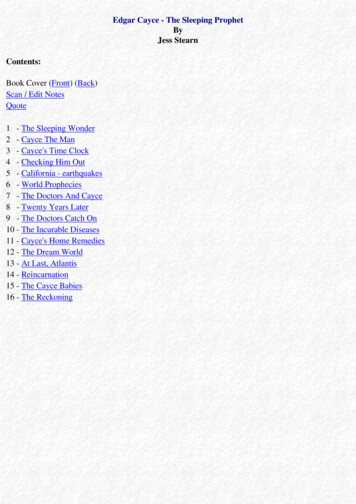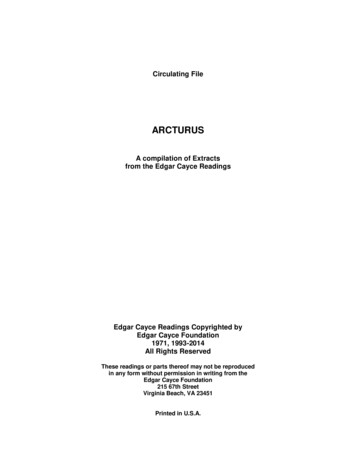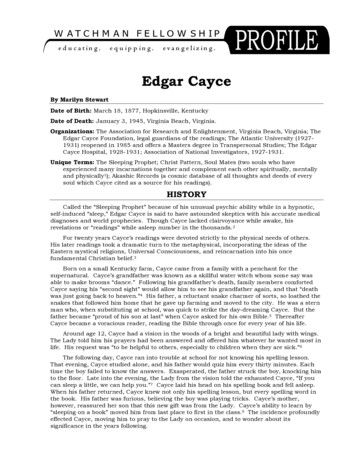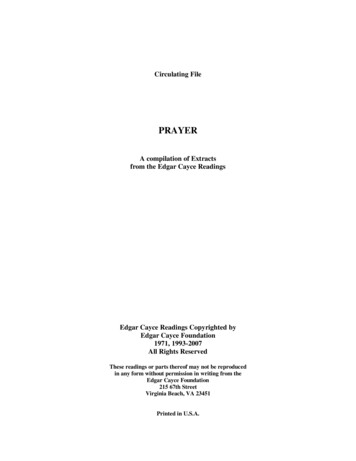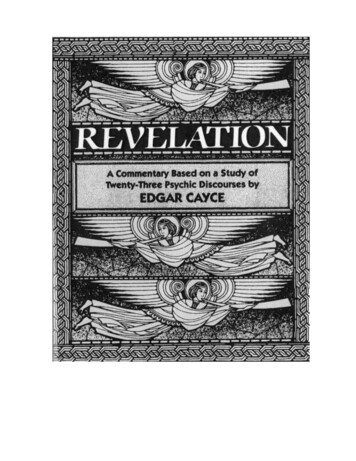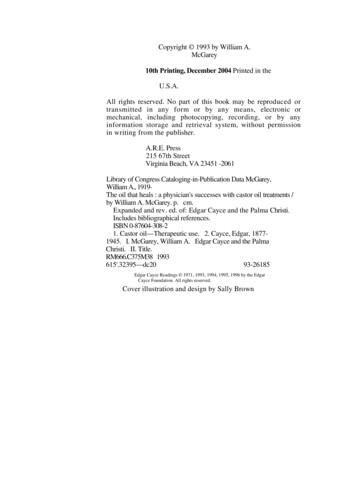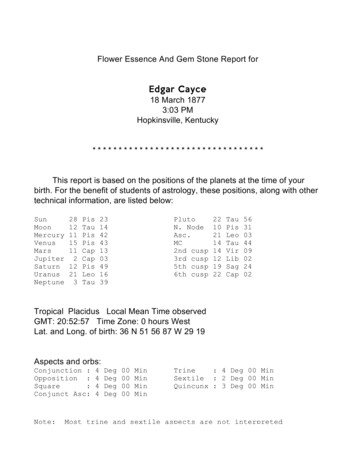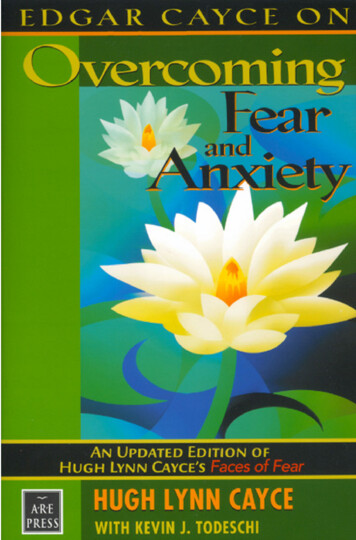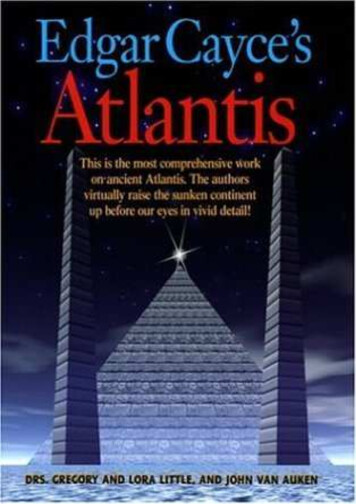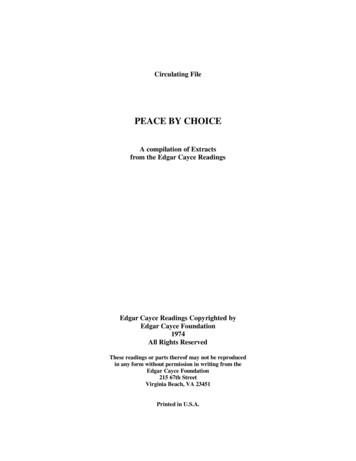
Transcription
Circulating FilePEACE BY CHOICEA compilation of Extractsfrom the Edgar Cayce ReadingsEdgar Cayce Readings Copyrighted byEdgar Cayce Foundation1974All Rights ReservedThese readings or parts thereof may not be reproducedin any form without permission in writing from theEdgar Cayce Foundation215 67th StreetVirginia Beach, VA 23451Printed in U.S.A.
PEACE BY CHOICE CIRCULATING FILEEdgar Cayce Readings copyright 1974 by the Edgar Cayce Foundation2
PEACE BY CHOICE CIRCULATING FILEContentsForeword5Chapter One“Peace Is More than the Silence of Cannons”6Chapter TwoProve Me Now21Chapter ThreeWithin Thine Own Self34Appendix49Related Circulating Files*:1. Peace2. Serving in Accord with Ideals3. “That Ye May Heal”4. Understanding the Purpose of Life5. World Affairs Readings*Circulating Files & Research Bulletins are available from A.R.E. membership services at (800)333-4499 or: http://www.edgarcayce.org/circulatingEdgar Cayce Readings copyright 1974 by the Edgar Cayce Foundation3
PEACE BY CHOICE CIRCULATING FILEDedicatedto aNew Order of AgesEdgar Cayce Readings copyright 1974 by the Edgar Cayce Foundation4
PEACE BY CHOICE CIRCULATING FILEForewordTwo outstanding facts characterize the world today: division and interdependence.At all levels of human organization, we find ourselves unable to get along with oneanother, and we find ourselves equally unable to get along without one another.This dilemma is enacted daily wherever ambassadors of this world's peoples orrepresentatives of their enterprises meet to do business—be it the business of diplomacy,of science, of commerce, of cultural exchange. We find it at international conclaves. Wefind it in national assemblies. We find it in state capitols, in city halls, and in townmeetings. We find it in neighborhood gatherings. It has invaded all zones and sectors ofhuman endeavor.Delegates from the one side and leaders of the other side can't get along with oneanother, but they can't get along without one another either. And, within their respectiveinstitutions—be they labor unions, corporations, religious orders, nation-states, or ParentTeacher Associations—the same inability to do with each other or without each otheraffects relations between leaders of organizations and rank-and-file members whoseinterests they are supposed to represent and serve. In the mass media we find it, too.Information and public relations come into conflict; cultural values and commercialrequirements run into the dilemma day-by-day. Citizens, political parties, office-holders,interest groups are all in it—divided, but interdependent. We work, and we consume—atcross-purposes. Division and interdependence—the story of our neighborhoods, ourfamilies, perhaps ourselves.Tension, ambiguity, uncertainty accompany our present situation of being ableneither to subsist alone nor to work together. The resultant strains give rise to twopredominant moods: anxiety and discontent.These conditions have become extreme. They are reflected in the statisticalprevalence of psychosomatic, psychoneurotic, and sociopathic problems. And, if we thinkthat any of these problems can be eliminated through more automobiles, more televisionsets, more jobs, more welfare, bigger airplanes, taller buildings, higher salaries, longervacations, or "more" or "bigger" anything we're now producing, we're wrong, and theprice of our error will be cultural and civil decline and destruction.We live in a society, we live in a culture, we live in a world—none of whichpossesses the balance, the rhythm, the integration necessary for survival. To persist in ourconventional thought patterns, to react in our accustomed ways is to assure our collectivecollapse.The alternative to collapse is creativity; the alternative to anxiety and discontent islove and joy; the alternative to division and interdependence is a new consciousnessbased on recognition of universal law. The availability of these alternatives to us dependsupon the exercise of choice.What shall we choose? Peace, or war? Abundance, or destruction?Edgar Cayce Readings copyright 1974 by the Edgar Cayce Foundation5
PEACE BY CHOICE CIRCULATING FILEChapter One"Peace Is More than the Silence of Cannons"Peace is within the grasp of any individual today—as it has always been—and iswithin the reach of humanity in this generation. If we fail to obtain peace, it will bebecause we do not want it, not because we cannot have it. It will be because we chose thediversions and the deviations rather than the way of least resistance, because we preferred"the devil we know"—perhaps because of ignorance or fear about what peace is—ratherthan the life and joy that could be ours.Do we know what we ask for when we ask for peace? Maybe we know by directexperience in our individual lives what peace is. If not, we might feel confused about thedesirability and the feasibility of world peace. Both clarification of experience and relieffrom confusion can be sought and found through inquiry in the Edgar Cayce readings,selections from which are considered here in correlation with some parallel viewpoints.The concept which emerges is that peace is a thing in itself—not an absence of war, notthe opposite of war, but a thing in itself. It is not an end in itself but a means, rather, formaking life more manifest. A preliminary definition might be that peace is conscious,consenting harmony with the One Life in Whom we live and move and have our beingand Who is in us, and with our fellow men who share with each of us that same Life.The late Dominique Pire of Belgium, winner in 1958 of the Nobel Peace Prize,said this:"Peace is more than the silence of cannons! It represents a state of harmony. Itbears no relation to 'peaceful coexistence' which is merely a cloak for the chicanery,the bitterness, the ideological clashes and the racial and nationalistic prejudiceswhich smoulder towards explosion in many parts of the world."In fact, it is not physical disarmament which counts, but the disarmament ofhearts and minds. The advent of true peace does not depend solely on the wisdomof the great powers, but also on the modification of human thinking and humanrelationships, and on the dialogues which each of us must agree to undertake withothers. The last third of this century will be what men make it. Our responsibility isplain."1Why Not Peace?The worst stumbling block to peace is separatism:Q. What do the Forces say regarding my chances for peace and happinesson earth?A. Peace and happiness, harmony, will be the lot of the body; for the bodyphysically and mentally should know—and hold within self—this:I AM PERSUADED THAT NEITHER MINDS OF OTHERS,PRINCIPALITIES, NOR FORCES OF ANY NATURE, MAY SEPARATE MEFROM THE JOY, THE PEACE, THE HAPPINESS, MY MAKER HASPREPARED FOR ME.And HE will bring it to pass!911-2Edgar Cayce Readings copyright 1974 by the Edgar Cayce Foundation6
PEACE BY CHOICE CIRCULATING FILESeparatism is also singled out by Alice A. Bailey as the barrier to peace. She depictspeace this way:"What is peace? It is essentially the establishing of right human relations, ofsynthetic rapport with its resultant cooperation, of correct interplay between the threeplanetary centres and an illumined, loving understanding of the will of God as itaffects humanity and works out divine intent."2This is explained by Lillian T. Schutte:"The sequence is goodwill, right human relations, then peace. The worldemphasis in human planning today is laid on peace; but peace can only come as theresult of right human relations based on the will to that which is right for all. Humanconsciousness has grasped the end, but has not recognized the necessary means." 3Thus, separatism—or cleavage or schism—is the obstacle to peace. It is the main obstacleto right human relations, which is needed prior to peace, and to goodwill, which isrequired for right human relations.Separatism is the result of us-them and we-they thinking which 1 puts suspicionand distrust between ourselves and others, alienates us from our inner selves, anddisconnects us from our Creative Source. Separatism arises from rogue thoughts andfeelings—such as hate, fear, anger, envy, malice, pride, arrogance—which, like I germs,produce dis-ease and foment hostile outbursts. Little progress toward peace can beanticipated until we recognize that the world situation today can be laid at the doorstep ofall of us and of each of us. It is not the fault of any single person, race, or nation. It is theoutcome of widespread envy, hate, and fear, producing separative attitudes. Is there anyone of us who has not at some time sought for scapegoats rather than looked at self?Separatism inhibits comprehensive and inclusive dialogues on planning to buildpeace owing to the difficulty of bringing together in the same forum certain kinds ofpeople and certain sorts of interests. For example, militarists dismiss approaches in whichthe use of armed might is not involved, and pacifists reject discussion of force as a meansof keeping the peace. Any trace of arrogance on the one side or of smugness on the otherside incites hostility. Typically, attention to economic welfare and social justice isconsidered as essential for negotiating peace arrangements. But persons, groups, andnations in relatively advantaged positions are reluctant to reduce their position, eitherabsolutely or comparatively, and persons, groups, and nations in relatively disadvantagedpositions refuse to accept a status quo which would keep them in their present condition,either absolutely or comparatively.Difficulties produced by separatism are such that usual peace proposals, bydefault, define peace as "the silence of cannons," as an absence of war, or as the oppositeof war. And they seek to avoid war by preventing hostile outbursts.Whether we see peace as the opposite or an absence of war or as a thing in itself,barriers to peace and causes of war are similar. Shall we look at some viewpoints on these?Religious writers speak of the failure of man to prevent greed and aggressivenessfrom getting the better of understanding and compassion. Secular writers refer to nationalpride, collective materialism, thirst for economic or political power. Psychologistsimplicate unconscious motives such as desire for prestige, power, and possessions, virileself-image, territorial self-image, rationalization, projection.Edgar Cayce Readings copyright 1974 by the Edgar Cayce Foundation7
PEACE BY CHOICE CIRCULATING FILEThe causes of war indicated in the Cayce readings are selfishness, fear, andunbelief. These correlate respectively with what psychologists tell us are thecharacteristic rumors which precede and accompany hostile outbursts: wedge-driving,bogey, and pipe-dream rumors.Neil J. Smelser, a sociologist, associates hostile outbursts with cleavage(separatism), inadequate communication or improper use of communication (includingrumor, omission, distortion), ambiguity about who is in authority, and ignorance. 4 Hostileoutbursts might take such forms as aggressive nationalism, scape-goating, racism, andsexism.Alexander Mitscherlich, a psychologist, specifies three mischief-makingprocesses: shifting our feelings from ourselves and attributing them to others, projectinginner conflicts, and denial. The two main obstacles to peace, according to him, are easilyaroused hostility of man to man and hard-core stupidity.5Evan Luard, a political scientist, finds that "conflict is especially common inambiguous situations where sovereignty is obscure or the international rulebook isunclear.”6 Intolerance of ambiguity is widely recognized in the social sciences as a factorwhich can be readily exploited to foster aggression, belligerence, and hostile behavior. 7Breakdowns in intelligibility were cited by the ancient historians Herodotus andThucydides as causes of war. It makes sense, does it not, that when people behaveseparatively, things become unintelligible.Is there an implication running through these viewpoints that obstacles to peaceand causes of war have something to do with having forgotten our Source, our Purpose,and our essential oneness?Because so much peace discussion supposes peace is the absence of war or theopposite of war, we should clarify our thinking on this. Can we produce an absence? Wecan no more produce an absence than we can prove nonexistence. As a matter of methodor procedure, we make trouble for ourselves if we define peace as the absence of war.What if we regard peace as the opposite, or antithesis, of war? This fosters dualism andseparatism, does it not, and subverts efforts to encourage synthesis and oneness. Unwisedefinition of peace probably accounts for much failure to obtain it.Traditional and Contemporary Plans for Peaceand How to Assess ThemWorld law and federal union models for arranging peace have been offeredprolifically. Dante's De Monarchia (On World-Government) is a classic statement and,more subtly, a critique of such plans: superficially, world government is logical andlaudable; psychologically, it is laughable under existent conditions—then and now.Nevertheless, world law and federal union have numerous proponents and commandattention as eventualities.Historically, a method for discouraging hostile actions has been deterrence, mostoften exemplified by force-in-being and by hostages in enemy hands. The uses of force,or military preparedness, are ancient, common, and familiar to most people. The use ofhostages is also ancient and common but less familiar to many people although it is stillpracticed in modern days. Some governments continue to hold family members hostageat home for the good behavior of other family members who are traveling, working, orEdgar Cayce Readings copyright 1974 by the Edgar Cayce Foundation8
PEACE BY CHOICE CIRCULATING FILEstudying abroad. In the traditional use of hostages to prevent hostile outbursts inconquered lands, persons were taken from those places for the good behavior of the oneswho remained at home. It was as a hostage for the Achaean League that Polybius, theGreek soldier-scholar-statesman, was taken, among others, to victorious Rome in thesecond century B.C. His political scholarship, carried out and published in Rome,influenced the development of Roman government and significantly affected Westernconstitutional theory.Some peace advocates propose an exchange of volunteer hostages betweenantagonistic nations as a way of reducing conflict and, through cultural sharing such asthat done by Polybius, promoting understanding.Aerospace technologies have opened other possibilities: spy satellite networkscovering the entire world with access for all interested parties, governmental andnongovernmental; establishment of transnational public corporations in which anyonecould buy stock in civilian ventures at colonization of the moon and other planets;international governmentally sponsored projects in space research and planetaryexploration and settlement.The suggestions reviewed so far require multilateral co-operation. There also areunilateral possibilities: doomsday devices, for example, and, in contrast, unilateraldisarmament concomitant with conversion to nonviolent foreign relations.How realistic are these plans? As causes of peace, they fail. As effects of peace,some might materialize.Elliott Frauenglass has proposed a method usable by the informed layman forcomparing the feasibility of various peace proposals!8 He analyzes three major aspectsgenerally characteristic of peace proposals: (1) power, (2) peace-keeping, and (3)partnering. Power is relevant to (a) prevention of attack, (b) defense, and (c) retaliation;pacification, to (a) removal of wrongs, (b) removal of fears, and (c) removal of covetouscravings; partnering, to (a) physical co-operation, (b) cultural sharing, and (c)interpersonal relationships. Scoring is done by Frauenglass according to five criteria: (i)cost, (ii) availability of appropriate technology, (iii) socio-political change required, (iv)positive effect for preventing attack, (v) negative effect of favoring war in outside areas.Through application of his scoring system, Frauenglass shows specific inadequacies inschemes for a civilian moon rocket, settling the moon and other planets, a public spysatellite system, federal union, and volunteer hostage exchanges.Other possibilities which depend on doomsday devices fail of desirability, even ifnot of feasibility. Unilateral disarmament with nonviolent foreign policy requires priorsocio-political and psychological changes not acceptable on a national level so far.This does not mean that peace is out of reach. It only means that peace is not to begrasped at this time by these methods. The Edgar Cayce readings do provide analternative plan for obtaining peace in which the cost is negligible, the technology isavailable, the socio-political changes are products rather than prerequisites, attack isprevented, and war is not merely shoved into outside areas. This alternative approachdepends upon the efforts of individuals and of small groups which are interlinkedspiritually. It is nongovernmental and noninstitutional. It is nonseparative and is nothampered by differences of nation, race, sex, or age. It emphasizes mental rather thanmaterial factors.Edgar Cayce Readings copyright 1974 by the Edgar Cayce Foundation9
PEACE BY CHOICE CIRCULATING FILEIf the claims for the proposal or the details of the proposal itself arouseincredulity, instead of closing our minds, let us recognize some facts: Most people whoavoid the study of politics and world affairs do so not because they do not want peace butbecause they do not know what they could do to improve world conditions and to obtainpeace. They think they lack what it takes to produce peace. But what does it take toproduce peace? Is large organization required? Vast sums of money? High office?Enormous prestige? The answer has to be no. These have repeatedly been tried, and theyhave not secured peace.Peace as a State of Mind"Mind is the builder," of peace or of any other condition. The mental plane is theplane of causes, and from this plane control can be exercised over effects—and also overorganization, wealth, power, and prestige—"for weal or woe." Thoughts are things andcan ' become either crimes or miracles. This thesis, reiterated throughout the Cayce files,is also stated in the Constitution of the United Nations Educational, Scientific, andCultural Organization (UNESCO):“. . . since wars begin in the minds of men, it is in the minds of men that thedefenses of peace must be constructed .“. . . a peace based exclusively upon the political and economic arrangementsof governments would not be a peace which could secure the unanimous, lasting andsincere support of the peoples of the world, and . . . peace must therefore be founded,if it is not to fail, upon the intellectual and moral solidarity of mankind."Is this not what we find pervading the Cayce readings? If self-aggrandizement isthe motive, no real good can come. If service is the motive, helpful results can beexpected. There can and must be the application of self for the manifestation of thecreative influences or ideals, but not application for self—for self-indulgence, selfaggrandizement.In order to make this approach effective, it would help not to restrict ourselves bybuilding hindering thought forms through scoffing and doubting:. . . the Mind is the Builder in material things. It is that association or thatconnection between the material and the spiritual forces, or the without and thewithin, and their coordination within the physical functionings of the body itselfbrings that the individual builds within self.Then, think CONSTRUCTIVELY! Do not make for negative forces thatcreate barriers or hardships in any way or manner. For these must eventually comeback to self.1192-6Also, it will work more readily for us if we abstain from self-deprecation:The entity should refrain from making or drawing comparisons as to othersand thus belittling self.1792-2Edgar Cayce Readings copyright 1974 by the Edgar Cayce Foundation10
PEACE BY CHOICE CIRCULATING FILE. . . it is almost as an axiom to say Be Patient, Be Gentle—with self as well aswith the influences about self; in remaining as quiet within the more often, knowingthat though one goes through the trials, though turmoils arise, there is ever within self,through the associations of self in its deeper forces with the influence of the Infinite,that which will bring to the body, to the mind, in the physical forces about the body,the peace and the quietude that only brings real help.1192-6Radiation—or contagion—is the operational method of the proposed peacestrategy, so it behooves us to do nothing to thwart radiation but, rather, to let results occurand spread in a relaxed, uninsistent, yet uninhibited way.Condemn not, that ye be not condemned; but as that peace He hath promisedcomes to thy consciousness, more and more the material environs will become inkeeping with the NEEDS of that to MAKE thee AWARE of His presence abidingwith thee.2427-1Let the purposes be creative, ever—as indicated in the desire for helping others.Remember—body, mind, soul—they each have their part in the physical, mental andspiritual welfare of individuals. Thus apply same in their proper relationship one toanother, and we will find more of contentment, more of peace in the experience of theentity.3034-1How does this compare with the Universal Declaration of Human Rights whichstates that ". . . recognition of the inherent dignity and of the equal and inalienable rightsof all members of the human family is the foundation of freedom, justice and peace in theworld."Failures of peace plans heretofore have been partially due to the level oforganization—nation or empire—on which they were instigated. Success requiresindividual commitment and effort, then unfoldment of group, class, and massparticipation in inner spiritual values:. . . there is no expression of the divine save where peace reigns within theindividual, and where that as a united effort may be the part of the experience of a city,a country, a nation. For, all were of one mind, that the glory of the Lord God might bemanifested, in all phases of human experience through those periods of activity.1541-11Is not the gist of this the same as that of Pope John XXIII in Pacem in Terris:"Human society demands that men be guided by justice, respect the rights ofothers and do their duty. It demands too that they be animated by such love as willmake them feel the needs of others as their own and induce them to share their goodwith others, and to strive in the world to make all men alike heirs to the noblest ofintellectual and spiritual values Peace on Earth—which man throughout the ageshas so longed for and sought after—can never be established, never guaranteed,except by the diligent observance of the divinely established order."Edgar Cayce Readings copyright 1974 by the Edgar Cayce Foundation11
PEACE BY CHOICE CIRCULATING FILEHow does one contact the "divinely established order"? Where is it found? Whydid Cayce readings send so many individuals to Deuteronomy 30? The divine is within, isimminent, is it not? There peace can be found and there the world order model can becontacted. There is no other way and no other order by which genuine and lasting peacecan be obtained. First, peace must be achieved within self; then, it must be shared.Specific references to the priority of achieving peace within self are found innumerous Cayce readings (see Appendix, p.49), typical of which are these:You must find harmony within self, you must find security within self, as has beenindicated. Ye cannot create it about you until you have it within yourself.2970-1If ye would have peace it must be first within self, and ye must be peaceful andcreate peace wherever you go, with whomever ye contact, and not dissension.2987-1A house divided against itself does not stand. A doubleminded individual fails toimpress anyone or to make for peace or harmony within self's expression.1244-1. . . unless founded in spirit it must continue to bring disturbances mentally ANDmaterially. For peace, harmony and ASSURANCE, of the NOW and the hereafter, maycome only in being at peace with self.1082-3Know, it is as has been given of old, "Lo, it is within thine own self that ye must findpeace, if ye would have peace with others." If you would have friends, show thyself friendly,if you would have love, be lovely in thy treatment of and thy associations with others. If youwould find patience, brotherly love, kindness, manifest it in self and it will come to thee.2509-2Begin in thine own self and with the one next to thee, and that which is notapplicable in the life of thy son, of thy wife, of thy brother, ye cannot apply in a universalsense. Begin with self. Find the peace in self and ye will find that ye can bring it to others.For as indicated, "It must needs be that offenses come," that disturbances arise, but fearnot, for thy Ideal has overcome the world. And as ye abide only in Him may ye be at peacewith the world.3902-2For thy presence oft brings peace to others . But it must be within self first, beforeye may give it to others.2376-4The necessity of giving in order to keep is stressed in connection with many goodqualities in the readings and also in regard to peace (see Appendix, p.50):Ye may only possess that which ye give to others. Thus, as ye give thy love, thy joy toothers, ye possess in the soul and the heart of thee that peace that is promised truly in Himwho is the Prince of Peace .2988-2Remember, ye pursue peace, ye embrace peace, ye hold to peace. It is not somethingthat descends upon thee, save as ye HAVE created and do create it in the hearts, in theminds, in the experiences of others.3051-2Edgar Cayce Readings copyright 1974 by the Edgar Cayce Foundation12
PEACE BY CHOICE CIRCULATING FILECreative Concept of PeaceWhat is needed—and what we are called upon to experience and to radiate—is acreative concept of peace. What has this to do with peace as sought and discussed inworld affairs? It is altogether different. It is not peace as the world knows peace. This weare told in numerous readings (see Appendix, p. 51).Has there been an excess of talk about peace and a lack of individual experienceand direct knowledge of it? Frank Herbert, a science-fiction writer, explains it this way:“ 'Another lesson,' Stetson said. 'The most important point on the aggressionindex: peaceful people, really peaceful types, don't even discuss peace. They havedeveloped a dynamic of nonviolence in which the ordinary concept of peace doesn'teven occur. They don't even think about it. The only way you develop more than acasual interest in peace as we conceive of it is through the recurrent and violentcontrast of war.' "9Thus, let us:Cry not "Peace, Peace" when thou, thyself, hast not shown peace to thy brethren!.Learn that quiet first within self, from within, through those applications not only of thematerial things but from the counsel and meditating from within self .694-2Aid to others brings release, brings peace, brings harmony. For, remember, as Hispromises were then, as they are today: "My peace I give you, My peace I leave with you; notas the world knoweth peace," not of ease, but rather that as of the conviction within selfthat "Others may do as they may, but as for me, I will serve the living God."2786-1Peace must be co-operative and companionable. Another version of thepreliminary definition of peace offered earlier might be that peace is conscious,consenting companionship and co-creativity with the One Life, experienced first withinself and then manifested in our relationships with our fellow men.Truce or détente should not be mistaken for peace. These are expedients only,stop-gap measures which halt the fighting long enough for some recovery to take place.Détente and peace are distinguished here:. . . the ideals that the entity sets before self, the goals the entity expects and attemptsto attain, will make for those conditions as will bring that that makes for contentment andpeace, or whether they bring those conditions that with use wear away. Oft has it been said,and well were it that all consider—friendships and loves that are builded on peace grow,while those things that partake of earth become weather-worn, and with age unfit, unuseful;yet those that partake of those things that bespeak of the abilities that come with love in itshigher sense build, grow more beautiful as time, age, comes on.2364-1Peace is everlasting, but not rigid, ever-growing, but not rampant. It is development, butnot imperialism. Peace provides for revitalization and renewal, but it is not an armisticeduring which rearmament can be accomplished, nor is it a police state in which masterslave arrangements deter shows of hostility.Edgar Cayce Readings copyright 1974 by the Edgar Cayce Foundation13
PEACE BY CHOICE CIRCULATING FILEThe creative concept of peace demands that peace be for a purpose, that it not bean end in itself. It is, in this sense, like truce or détente, an expedient, but a different kindof expedient altogether—the purpose of peace being to demonstrate the joy of living:Study to show thyself approved, in all good consciousness, to thy Lord and thyGod—as is shown in Jesus; rightly dividing and and divining the words of truth . Walkand talk oft with thy Lord in thy own temple; and may there be done there that as willbring to thy mind, thy body, thy soul, PEACE—His peace I give you—His peace I wouldhave thee seek! For only in that may ye know the joy of living!954-5Power in the Cayce Peace ModelJesus the Christ is the authority for humanity on peace; the Christ is the authorityfor peace, according to the Cayce readings:. . . all might, all power in heaven and in earth has been given into His keeping. For,He—having overcome the influences of the world of matter, being endowed with the spi
PEACE BY CHOICE CIRCULATING FILE Edgar Cayce Readings copyright 1974 by the Edgar Cayce Foundation 6 Chapter One "Peace Is More than the Silence of Cannons" Peace is within the g
